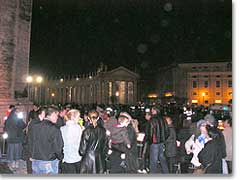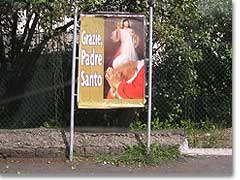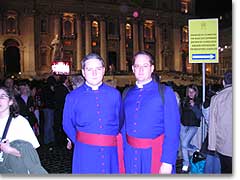 |
|
Miles de peregrinos en la Plaza San Pedro The crowds inside Bernini's "arms" of columns, looking north towards the Porta Sant'Ana (Saint Anne's gate). Tausende von Pilgern auf dem Petersplatz |
|
 |
|
Iglesia de Jesús y María, Via del Corso. El cartel arriba de la foto del Santo Padre dice: Adios, Lolek, amigo, martir de la humandad. Que la Virgen te recibe en el umbral. The Church of Jesus and Mary (Gesù e Maria) on the Via del Corso. The message above the Pope's picture says: "A Dio, Lolek, amico, martire dell'umanità. Maria ti accolga sulla soglia", that is, "Goodbye (lit. 'to God') Lolek, friend, martyr of humanity. May Mary welcome you on the doorstep')". Kirche Gesú e María auf dem Via del Corso. Der Text über dem Papstfoto heißt: Adio, Lolek, Freund, Märtyrer der Menschlichkeit. Möge Maria dich auf der Schwelle empfangen.“ |
|
 |
|
Cartel de la diocesis de Roma: Adios, Santo Padre. Diocese: Goodbye, Holy Father Plakat der Diözese Rom: Danke, Heiliger Vater |
|
 |
|
Seminaristas desilusionados Disappointed seminarians Enttäuschte Seminaristen... kein Zugang mehr. |
|
 |
|
Memorial popular: velas,.cartas At the foot of a column: candles and letters in memory of the Holy Father Spontane Gedenkstätte an einer Säule |
|
 |
|
Una de las pantallas grande que hay en toda la ciudad The screen is in position for tomorrow. It is already broadcasting live TV from Saint Peter's: this is the inside of the cupola (dome) over the place where the Holy Father's body is lying. Einer der Großbildschirme, über die schon tagelang live aus dem Petersdom übertragen wird Fotos: Donnelly © 2005 |
|
|
ROME, Simon Donnelly. Rome is overwhelmed, in every sense of the word: a million people have been standing in line to the mortal remains of the Holy Father, Karol Wojtyla. Everyone knew he was a much loved pope, but noone realised it would come to this! Last night, the queue to see him started at the front doors of the basilica, continued down the Via della Conciliazione (past the German pilgrim centre) — there were a few hundred thousand faithful just on that road alone — across the river!, and it continued on down the Tiber bank on the other side (Lungotevere). Local papers said the city itself estimates a million people waited in line. And they waited, and waited. They moved as little as 10 metres every hour. And some had more than a kilometre to walk, which means they simply were not going to reach the doors of the church before the Holy Father is put to rest.
The fact that it can be done—and it is being done, in a superb way by the Italian state and local government authorities—is a tribute both to the Italian state, and to the Italians as a nation. They have simply risen to the occasion. This is bigger even than the Jubilee Year celebrations in the year 2000. In fact, the scale of organisation required is the same as that, in many ways, but it had to be done in 48 hours! In this great city, where nothing seems to work, the amazing thing, as a German friend pointed out, is that somehow... it works, nevertheless! For a Germanic or English person, Italian bureaucracy is a nightmare. There seem to be no rules! And yet, and yet... in two days, the city of Rome has laid on facilities for millions of anticipated faithful at the papal funeral tomorrow.
We want to see John Paul II
The city can hardly cope, and yet it is coping. This morning the Rome government through the Protezione Civile [Civil Guard] sent out many millions of SMS messages (to all Italian cellphones): "Enormous influx [of people]. From Wednesday 10pm, the lines to greet the Holy Father are closed. On Friday, for the funeral, traffic in Rome is stopped. The area of St Peter’s is full. [Maxi]screens are in squares and at Tor Vergata." The city is considering closing part of its southern freeway (Autobahn!) ring, to turn it into a car park.
Not only have hundreds of thousands of Italians come to see their pope, but more than a million Polish people have come to Rome, also to see him, and if not to see him, then to bid him goodbye from as near as they can get to St Peter’s Basilica. There are Poles who have arrived with nothing more than the clothes they are wearing, and deep faith in God that they will survive somehow. Fortunately, it is springtime here, and many Poles are simply sleeping on the streets. I’m sure many are hungry right now, but they honestly do not seem to care. The city is providing free water, and toilets, and possibly sandwiches too. But the Poles seem to be happy simply that they can be here. It is a totally inspiring experience simply to walk among the crowds on the streets. ‘If your faith was the size of a mustard seed...’. The city is full of mustard seeds these days.
There are Boy Scouts and Girl Scouts with their priest chaplains, other youth groups with their priests, or with a religious sister, or just on their own. There are groups of sisters, and priests, with everyone else in the queue, not trying to get any special treatment. Their solidarity is a beautiful example for me. The Croatian sisters from our college waited in line for seven hours, and then gave up and came home. I know they were disappointed. I’m not sure they were even in the main queue yet. They were in one of two giant lines that fed into the main queue.
"Invasion of the faithful"
And everyone has a personal story. Last night, a young Italian woman named Sabrina stopped me and asked me if I could get her into the Basilica. I said I couldn’t, and she was so disappointed. She had driven from somewhere in Italy, and just parked her car on any street, hoping she wouldn’t get a fine. She decided that the best thing to do was simply stand at the bottom of the Via della Conciliazione, where all the media crews are, and to say a prayer for her pope. She said to me the spirit of God lived in him. There was no pretense to theology: it was a fact for her.
What I didn’t try to explain to Sabrina was that I had indeed tried to get into the basilica last night, with two seminarian friends who so much wanted to see the Holy Father a last time. Our brightly coloured soutanes (cassocks) did nothing to impress anybody. After much haggling and hand-waving, we passed, somehow, through five levels of security, as got nearer the basilica. We were finally on the steps of the church itself, and at that point were turned back (perhaps because the three American presidents—none even Catholic!—were about to pay their tribute). I was blessed to have seen him on Monday. One of the others would still find a way in this morning, with a Cardinal. A man in red could take in who he wished. But at one point we saw even an elderly Bishop who was not allowed to take in anyone with him. Instead of himself slipping in a side door, he went to wait with his friends in another line. The example of quiet humility was deeply inspiring to us. As my friend who hasn’t gotten in at all said: "When I saw how badly others wanted to see him, and how much they had suffered to wait in line for so long (up to 15 hours), I didn’t feel worthy to get in ahead of them".
Once you leave the St Peter’s area, up towards the Olympic Stadium, there are hundreds of buses parked next to a giant tendopoli (‘tent city’), to house the pilgrims pouring in. The Roman mayor said this morning, in response to their ‘invasion of the faithful’ (as one of the daily free papers City phrased it): "Romans, open your houses". He asked the city residents to put up the pilgrims in their homes, as they did in the Jubilee year.
Posters paying tribute to the Pope
An American friend said to me what struck her and her son, as they waited in line for a dozen hours or so was the calm of the pilgrims, and the extraordinary politeness and kindness of the city police officials (which is highly atypical!). I saw non-Catholics, visible here and there because of a Muslim scarf. Seminarians from the Pontifical North American College, and others, walked among the crowds, prayed with them, asked them why they were here, offered encouragement. It is an inspiring thing for us seminarians, to see the deep and humbling faith of the Christians who have come simply to be here.
As we left the jammed (but organised) main piazza area in front of St Peter’s last night—that had been full only of quiet city dwellers five days ago, as the Holy Father lay dying—we stopped to look at piles of candles and posters left by people who have loved him, and wished to leave something for him. The signs are very personal, very intimate. These are not polite sentiments to a distant king, but words of love and affection to someone very close to their hearts.
Churches and shops have signs of farewell to the Holy Father. To pay him tribute, there are posters stuck up on walls, from groups whose names are written too small for us to notice. The main message is roughly: ‘Thank you! We will miss you terribly. And goodbye’. The posters of the Roman municipality say: ‘Thank You. Rome weeps, and salutes its Holy Father’. This morning on the Via del Corso — a major tourist street — outside the small church of Gesù e Maria there is a sign that says: A Dio, Lolek, amico, martire dell’umanità. Maria ti accolga sulla soglia: "Goodbye (lit. ‘to God’) Lolek, friend, martyr of humanity. May Mary welcome you on the doorstep’). ‘Lolek’ is his boyhood name, based on ‘Karol’. The poster from the Rome diocese says simply: ‘Thank you, Holy Father. -Your diocese’.
Celebrating the hope and joy of our Catholic faith
On the major piazzas, including Popolo, Navona, Risorgimento, and the Tor Vergata, there are 25 giant digital maxiscreens in place for tomorrow’s funeral, so that everyone can take part. We will celebrate not only Karol Wojtyla’s life, but also the hope and the joy that our Catholic faith offers us.
And the naysayers, the ones who said (and still say) rather gloomy things about this pontificate, seem to be struggling with the fact that the upsurge of emotion is completely out of proportion to any negative feelings we are told that many are supposed to have for the Holy Father. Some secular non-Italian media channels are carrying the preparations for the Pope’s funeral nearly 24 hours a day. It’s delightful to see how amazed they seem to be! To borrow from CS Lewis, we have been surprised by joy. It’s sweetly ironic.
Noone expected this level of outpouring of grief and joy. And now, all media simply must cover the event, because an event where as many as five million people are present cannot be overlooked!
This small man from a small town outside Krakow has effectively brought one entire country—Poland—and parts of another country—Italy, with its entire capital city—to a grinding halt.
Some parts of the outside world seem to be very interested in guessing about a future pope. But we find it almost sacreligious to talk in these terms. First, tomorrow, through our tears, we will lay in the ground our beloved pope, John Paul the Great—as he was called today by the head of the Department of Civil Protection, Gudio Bertolaso. Only then will we think of other matters.